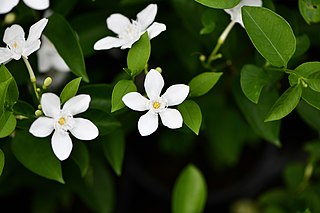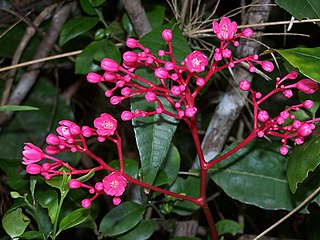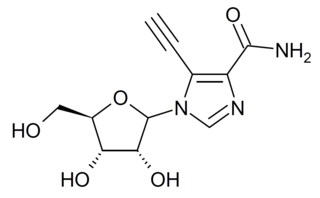
Idarubicin or 4-demethoxydaunorubicin is an anthracycline antileukemic drug. It inserts itself into DNA and prevents DNA unwinding by interfering with the enzyme topoisomerase II. It is an analog of daunorubicin, but the absence of a methoxy group increases its fat solubility and cellular uptake. Similar to other anthracyclines, it also induces histone eviction from chromatin.

Brucea is a genus of plant in the family Simaroubaceae. It is named for the Scottish scholar and explorer James Bruce.

Vitamin D5 is a form of vitamin D.
Cell-cycle nonspecific antineoplastic agents (CCNS) refer to a class of pharmaceuticals that act as antitumor agents at all or any phases of the cell cycle.

Arsthinol (INN) is an antiprotozoal agent. It was synthesized for the first time in 1949 by Ernst A.H. Friedheim by complexation of acetarsol with 2,3-dimercaptopropanol and has been demonstrated to be effective against amoebiasis and yaws. It was marketed few years later by Endo Products . Among trivalent organoarsenicals, arthinol was considered as very well tolerated. Recently, it was studied for its anticancer activity.

Romidepsin, also known as Istodax, is an anticancer agent used in cutaneous T-cell lymphoma (CTCL) and other peripheral T-cell lymphomas (PTCLs). Romidepsin is a natural product obtained from the bacterium Chromobacterium violaceum, and works by blocking enzymes known as histone deacetylases, thus inducing apoptosis. It is sometimes referred to as depsipeptide, after the class of molecules to which it belongs. Romidepsin is branded and owned by Gloucester Pharmaceuticals, now a part of Celgene.

Wrightia antidysenterica, the coral swirl or tellicherry bark, is a flowering plant in the genus Wrightia. Wrightia antidysenterica is sometimes confused with the species Holarrhena pubescens due to a second, taxonomically invalid publication of the name Holarrhena pubescens. It has long been known in Indian Ayurvedic tradition. It is known in Sanskrit as kuṭaja or ambikā and in Sinhala it is called වල් ඉද්ද. It is also known as "white angel" in the Philippines and in Thailand it is called "พุดพิชญา" (pudpitchaya).

Simarouba is a genus of trees and shrubs in the family Simaroubaceae, native to the neotropics. It has been grouped in the subtribe Simaroubina along with the Simaba and Quassia genera. They have compound leaves, with between 1 and 12 pairs of alternate pinnate leaflets. Their flowers are unisexual, relatively small and arranged in large panicles. The individual flowers have between 4 and 6 sepals and petals and between 8 and 12 stamens. The fruit is a carpophore and has up to 5 drupaceous mericarps.

Rocaglamide is a natural product which belongs to a class of molecules called flavaglines. This compound was isolated in 1982 by King and colleagues based on its antileukemic activity. Like other flavaglines, rocaglamide displays potent insecticidal, antifungal, anti-inflammatory and anticancer activities. Rocaglamide A (RocA) inhibits eukaryotic translation initiation by binding to the translation initiation factor eIF4A and converting it into a translational repressor.

Bruceanols are quassinoids isolated from Brucea antidysenterica.

Quassinoids are degraded triterpene lactones of the Simaroubaceae plant family grouped into C-18, C-19, C-20, C-22 and C-25 types. The prototypical member of the group, quassin, was first described in the 19th century from plants of the genus Quassia from which it gets its name. It was isolated in 1937 and its structure elucidated in 1961.

Brucea javanica is a shrub in the family Simaroubaceae. The specific epithet javanica is from the Latin, meaning "of Java". Other common names in English include Java brucea and kosam.

EICAR is a drug which acts as an inhibitor of the enzyme IMP dehydrogenase. It is a nucleoside derivative which has both anti-cancer and antiviral effects, and was originally developed for the treatment of leukemia, but was unsuccessful in human clinical trials. It has broad spectrum antiviral effects with activity against pox viruses, Semliki forest virus, Junin virus, reovirus, influenza, measles virus and respiratory syncytial virus among others, although it is not active against coronaviridae such as SARS-CoV-1. This useful spectrum of activity means that EICAR and related derivatives continue to be investigated for the treatment of viral diseases.

Bruceanol B is a cytotoxic quassinoid isolated from Brucea antidysenterica with potential antitumor and antileukemic properties.

Bruceanol C is a cytotoxic quassinoid isolated from Brucea antidysenterica with potential antitumor and antileukemic properties.

Bruceanol D is a cytotoxic quassinoid isolated from Brucea antidysenterica with potential antitumor and antileukemic properties.

Bruceanol E is a cytotoxic quassinoid isolated from Brucea antidysenterica with potential antitumor and antileukemic properties.

Bruceanol F is a cytotoxic quassinoid isolated from Brucea antidysenterica with potential antitumor and antileukemic properties.

Bruceanol G is a cytotoxic quassinoid isolated from Brucea antidysenterica with potential antitumor and antileukemic properties.

Bruceanol H is a cytotoxic quassinoid isolated from Brucea antidysenterica with potential antitumor and antileukemic properties.



















